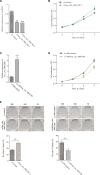Circular RNA profiles and the potential involvement of down-expression of hsa_circ_0001360 in cutaneous squamous cell carcinogenesis
- PMID: 33569895
- PMCID: PMC8016141
- DOI: 10.1002/2211-5463.13114
Circular RNA profiles and the potential involvement of down-expression of hsa_circ_0001360 in cutaneous squamous cell carcinogenesis
Abstract
Circular RNAs (circRNAs) act as sponges of noncoding RNAs and have been implicated in many pathophysiological processes, including tumor development and progression. However, their roles in cutaneous squamous cell carcinoma (cSCC) are not yet well understood. This study aimed to identify differentially expressed circRNAs and their potential functions in cutaneous squamous cell carcinogenesis. The expression profiles of circRNAs in three paired cSCC and adjacent nontumorous tissues were detected with RNA sequencing and bioinformatics analysis. The candidate circRNAs were validated by PCR, Sanger sequencing and quantitative RT-PCR in another five matched samples. The biological functions of circRNAs in SCL-1 cells were assessed using circRNA silencing and overexpression, 3-(4,5-dimethylthiazol-2-yl)-5-(3-carboxymethoxyphenyl)-2-(4-sulfophenyl)-2H-tetrazolium inner salt (MTS), flow cytometry, transwell and colony formation assays. In addition, the circRNA-miRNA-mRNA interaction networks were predicted by bioinformatics. In summary, 1115 circRNAs, including 457 up-regulated and 658 down-regulated circRNAs (fold change ≥ 2 and P < 0.05), were differentially expressed in cSCC compared with adjacent nontumorous tissues. Of four selected circRNAs, two circRNAs (hsa_circ_0000932 and hsa_circ_0001360) were confirmed to be significantly decreased in cSCC using PCR, Sanger sequencing and quantitative RT-PCR. Furthermore, hsa_circ_0001360 silencing was found to result in a significant increase of the proliferation, migration and invasion but a significant decrease of apoptosis in SCL-1 cells in vitro, whereas hsa_circ_0001360 overexpression showed the opposite regulatory effects. hsa_circ_0001360 was predicted to interact with five miRNAs and their corresponding genes. In conclusion, circRNA dysregulation may play a critical role in carcinogenesis of cSCC, and hsa_circ_0001360 may have potential as a biomarker for cSCC.
Keywords: circular RNA; cutaneous squamous cell carcinoma; expression profile; hsa_circ_0001360.
© 2021 The Authors. FEBS Open Bio published by John Wiley & Sons Ltd on behalf of Federation of European Biochemical Societies.
Conflict of interest statement
The authors declare no conflict of interest.
Figures






Similar articles
-
CircRNA hsa_circ_0070934 functions as a competitive endogenous RNA to regulate HOXB7 expression by sponging miR‑1236‑3p in cutaneous squamous cell carcinoma.Int J Oncol. 2020 Aug;57(2):478-487. doi: 10.3892/ijo.2020.5066. Epub 2020 May 14. Int J Oncol. 2020. PMID: 32626939 Free PMC article.
-
The study on circRNA profiling uncovers the regulatory function of the hsa_circ_0059665/miR-602 pathway in breast cancer.Sci Rep. 2024 Sep 4;14(1):20555. doi: 10.1038/s41598-024-71505-0. Sci Rep. 2024. PMID: 39232183 Free PMC article.
-
Circular RNA circ-LARP1B contributes to cutaneous squamous cell carcinoma progression by targeting microRNA-515-5p/TPX2 microtubule nucleation factor axis.Bioengineered. 2022 Jan;13(1):1209-1223. doi: 10.1080/21655979.2021.2019172. Bioengineered. 2022. PMID: 34982022 Free PMC article.
-
CircRNAs: a family number of miRNA regulatory transcriptome in laryngeal carcinoma.J Clin Lab Anal. 2021 Nov;35(11):e24038. doi: 10.1002/jcla.24038. Epub 2021 Oct 7. J Clin Lab Anal. 2021. PMID: 34617636 Free PMC article. Review.
-
The roles and mechanisms of circular RNAs related to mTOR in cancers.J Clin Lab Anal. 2022 Dec;36(12):e24783. doi: 10.1002/jcla.24783. Epub 2022 Nov 25. J Clin Lab Anal. 2022. PMID: 36426933 Free PMC article. Review.
Cited by
-
Circ_0084582 Facilitates Cell Growth, Migration, Invasion, and Angiopoiesis in Osteosarcoma via Mediating the miR-485-3p/JAG1 Axis.Front Genet. 2021 Aug 5;12:690956. doi: 10.3389/fgene.2021.690956. eCollection 2021. Front Genet. 2021. PMID: 34421997 Free PMC article.
-
Knockdown of lncRNA CCAT1 Inhibits the Progression of Colorectal Cancer via hsa-miR-4679 Mediating the Downregulation of GNG10.J Immunol Res. 2021 Dec 30;2021:8930813. doi: 10.1155/2021/8930813. eCollection 2021. J Immunol Res. 2021. PMID: 35005034 Free PMC article.
-
The Role of Circular RNAs in Keratinocyte Carcinomas.Cancers (Basel). 2021 Aug 23;13(16):4240. doi: 10.3390/cancers13164240. Cancers (Basel). 2021. PMID: 34439394 Free PMC article. Review.
-
Oh, the Mutations You'll Acquire! A Systematic Overview of Cutaneous Squamous Cell Carcinoma.Cell Physiol Biochem. 2021 Sep 22;55(S2):89-119. doi: 10.33594/000000433. Cell Physiol Biochem. 2021. PMID: 34553848 Free PMC article. Review.
-
Non-coding RNAs in skin cancers:Biological roles and molecular mechanisms.Front Pharmacol. 2022 Aug 10;13:934396. doi: 10.3389/fphar.2022.934396. eCollection 2022. Front Pharmacol. 2022. PMID: 36034860 Free PMC article. Review.
References
-
- Que SKT, Zwald FO and Schmults CD (2018) Cutaneous squamous cell carcinoma: incidence, risk factors, diagnosis, and staging. J Am Acad Dermatol 78, 237–247. - PubMed
-
- Karia PS, Han J and Schmults CD (2013) Cutaneous squamous cell carcinoma: estimated incidence of disease, nodal metastasis, and deaths from disease in the United States, 2012. J Am Acad Dermatol 68, 957–966. - PubMed
Publication types
MeSH terms
Substances
LinkOut - more resources
Full Text Sources
Other Literature Sources
Research Materials
Miscellaneous

